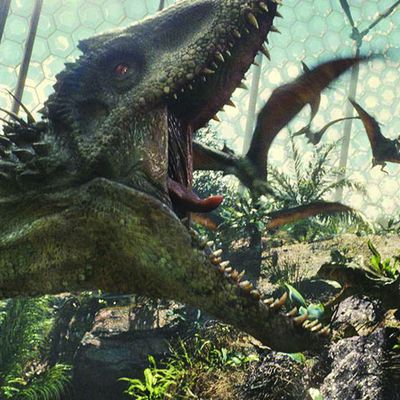
The American public have spared no expense in reminding the scientific community that we really like the idea of bringing dinosaurs back from the dead, and yet here we are, 20 years after Jurassic Park, and they still haven’t gotten the ball rolling on actually bringing dinosaurs back. What gives? Well, apparently the methods used in the films don’t really work, which is a fairly large hurdle. Even so, at least one scientist thinks that reconstituted dinos are a possibility in the somewhat distant future: Harvard geneticist George M. Church, a leading light in the “de-extinction” movement. Church was kind enough to discuss the science behind Jurassic World’s genetically engineered dinos; as it turns out, he’s optimistic that one day, it might actually be possible to grow a real, live dinosaur in a lab. It’s all very theoretical, but still, you might want to start stocking up on flares.
As an example, Church points to his current efforts, which are focused on bringing back the woolly mammoth. Thanks to a buffet of freshly discovered mammoth carcasses, DNA from the woolies is ripe for the taking. Church’s lab is plucking alleles from the genetic material and trying to merge them with elephant DNA to create a new mammoth-elephant hybrid than can survive on the frozen tundra. “We’re focusing on four traits,” he explained. “Blood hemoglobins [for surviving in cold weather], small ears, subcutaneous fat, and …” his voice trailed off for a second. “Hair! Can’t forget hair! Woolly mammoth, right?”
Church’s team is focused on developing mammoth embryos and organs in a lab so they can learn as much as possible “without bothering any elephants.” Eventually, he said, “We’d like to extend that embryonic development further until we can get a baby elephant in the lab.” The hybrids will hopefully be functionally similar to the mammoths of old: They will be covered in short hair, will have small ears, and will be comfortable breeding in -50 [degrees Celsius]. By that point, Church says, technology will likely have progressed to the point where it will only be a small step to producing new mammoths that are a 99.99 percent genetic match for the ones that used to roam the earth. “The hardest part is getting something that looks and acts like a mammoth,” he explained. “The rest is turning a crank.”
Mammoth enthusiasts, then, may have something to look forward to. But if you’re thinking it would be much harder to bring dinosaurs back from extinction, you’re correct. The limit for what Church calls “decent DNA” — the kind that’s preserved well enough to be used for these purposes — is 700,00 years. Dinosaurs have been dead 65 million years, and in real life, you can’t just pop open prehistoric mosquitoes to get their blood. Still, if you really wanted to build a theme park full of velociraptors, Church sees a theoretical workaround. “I would argue that we’re not limited by actual DNA,” he said. “You can re-create the ancient DNA by looking at the genomes of existing animals.”
Simply put, the theory is that you could take a dinosaur’s modern descendant and reverse-mutate its DNA to undo thousands of years of natural selection. Consider the ostrich. “What dinosaur traits are missing from an ostrich?” he asked. “The ostrich has a toothless beak, but there are mutations that cause teeth and claws to come back to their mouth and limbs. You need to replace the feathers with scales, but there are no feathers on their legs and feet, so you just need to make its whole body like its legs are. You don’t have to change every single base pair to get something that has dinosaur properties.”
But how would you fill in the inevitable gaps in the genome? Would you, say, replace them with the DNA of a tree frog or a cuttlefish, thus giving your reborn dinosaurs unexpected mutations that doom all your well-intentioned security measures? “I don’t know why Michael [Crichton] did that,” Church said. “I would not go with cuttlefish or frogs — they’re too far away.” (For the record, if you were going to use other animals to fill in the gaps, he thinks ostriches are “the ideal choice,” with lizards and crocodiles as other decent options.)
But, he adds, the plot twist that takes down each Jurassic theme park is based on an actual scientific phenomenon. “It’s called pleotropism,” he explained. “Where you have one gene will control many other genes. For example, in some animals, the clear lens in the eye is actually derived from an enzyme in their gut that digests carbohydrates.” That may sound slightly less exciting than dinosaurs that can camouflage themselves or change their gender, but just wait until you see what kind of exciting carb-digesting action sequences they’ve got planned for Jurassic World 2.
As for the idea of taming freshly ressurected dinosaurs, Church says it’s not that far-fetched that a hunky park ranger could form a bond with velociraptors based on trust and mutual respect — eventually. “You could possibly domesticate anything,” he told us, offering up a story about foxes. Over the course of a few decades, scientists in Russia conducted a domestication experiment on arctic foxes. In each generation of breeding, they mated the least aggressive foxes together and the most aggressive foxes together. Now they’ve got two different breeds: nice foxes and mean foxes. “It’s one of the few animals that we’ve watched be domesticated in our lifetimes,” Church told us. (In an unexpected twist, the nice foxes also ended up being adorable — in breeding for nonaggression, the scientists also ended up breeding for cuteness.) Given that any dinosaurs roaming a theme park would have been cooked up gene-by-gene anyway, Church sees no problem with the idea of velociraptors running side-by-side with a motorcycle, especially if they had the right kind of behavioral training. Someone get Chris Pratt’s little clicker thing!


